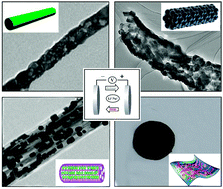Electrospun materials for lithium and sodium rechargeable batteries: from structure evolution to electrochemical performance
Abstract
Electrospinning has been growing increasingly versatile as a promising method to fabricate one dimensional (1D) designed architectures for lithium-ion batteries (LIBs) and sodium-ion batteries (SIBs). In this review, we have summarized almost all the progress in electrospun electrode materials for LIBs, covering the structure evolution from solid nanofibers into designed 1D nanomaterials, then 1D composites with carbon nanofibers (CNFs), and finally into flexible electrode materials with CNFs. Such a development trend in electrospun electrode materials would meet the battery technology and the strong consumer market demand for portable, ultrathin/lightweight and flexible devices. Along with the avenues of research about electrospun electrode materials for LIBs, electrospun electrode materials for SIBs are a rapidly growing and enormously promising field. As a timely overview, recent studies on electrospun SIB electrode materials are also highlighted. Finally, the emerging challenges and future developments of electrospun electrode materials are concisely provided. We hope this review will provide some inspiration to researchers over a broad range of topics, especially in the fields of energy, chemistry, physics, nanoscience and nanotechnology.



 Please wait while we load your content...
Please wait while we load your content...